Widespread Testing: Differing Strategies across Europe
The sudden arrival of COVID-19 required countries to rapidly develop their strategies for viral containment. One of the key elements of any response strategy - particularly when reopening countries - is widespread testing. However, the importance of testing was not universally recognised since the start of COVID-19. How did countries’ perspectives on testing change over time? And what can we learn from this for future outbreaks?
Approximately six months after the first COVID-19 case was identified in China in December 2019, the effects of the COVID-19 pandemic are increasingly visible. In the first months after the virus first occurred, the agendas of countries worldwide were dominated by COVID-19 related issues. With the deceleration of COVID-19 diffusion, the attention is again divided across other significant challenges, such as climate change and the rebuild of our economies. However, some COVID-19 related vocabulary will uphold a prominent place on the agenda, such as social distancing, contact-tracing and testing.
As countries are opening up, widespread testing turns out to be a key component of strategies and a pre-requisite in moving towards a life that is closer to ‘normal’. Countries across the world now appear to be ramping up their testing capacity, though testing was not a widely embraced measure when COVID-19 first appeared. Therefore, we will shed light on why testing is important and how the approach to testing changed over time amongst different European countries. Furthermore, we explore what lessons can be derived from COVID-19 testing strategies for future epidemics and pandemics.
Testing is of high importance in reducing risk of COVID-19 transmission and managing the pandemic
To reduce the transmission of COVID-19, it is key to identify swiftly where new cases are occurring and to have accurate numbers on the number of cases available. Implementing a strategy for widespread testing ensures that individuals who contracted COVID-19 can be diagnosed, isolated, and treated timely.
When deploying an effective contact-tracing system in addition to widespread testing, an increased number of individuals who may have contracted COVID-19, in particular those without experiencing its symptoms will be aware that they could potentially transmit the virus to others, and self-isolate to avoid further complications. As a result, the odds of a patient with COVID-19 transmitting the disease to others is lowered when tested.
Furthermore, testing data stands out as a crucial metric for countries to understand the severity and spread of the virus. Thus far, the number of cases and deaths has been occupying the headlines as an intuitive illustration of how countries are coping with the virus. However, the number of cases and the outlook for the future are strictly dependent on the number of people tested positive. Therefore, the severity of the pandemic will be underestimated if widespread testing is not a priority.
Thus, ramping up testing for both symptomatic and asymptomatic people allows countries to be on top of the pandemic, develop accurate containment measures, and allocate resources effectively, while mitigating the risk of undetected people unknowingly infecting others.
Getting to know the types of tests
When discussing the topic of testing, it is essential to be aware of the different types of tests conducted for COVID-19. Currently, there are two types of test available that are either used to identify an ongoing infection (PCR tests) or to trace whether the person was infected by the virus at some point in time in the past and fought it off naturally (serology tests). To give an overview of the similarities and differences between these tests, the European Data Portal created an infographic (figure 1).
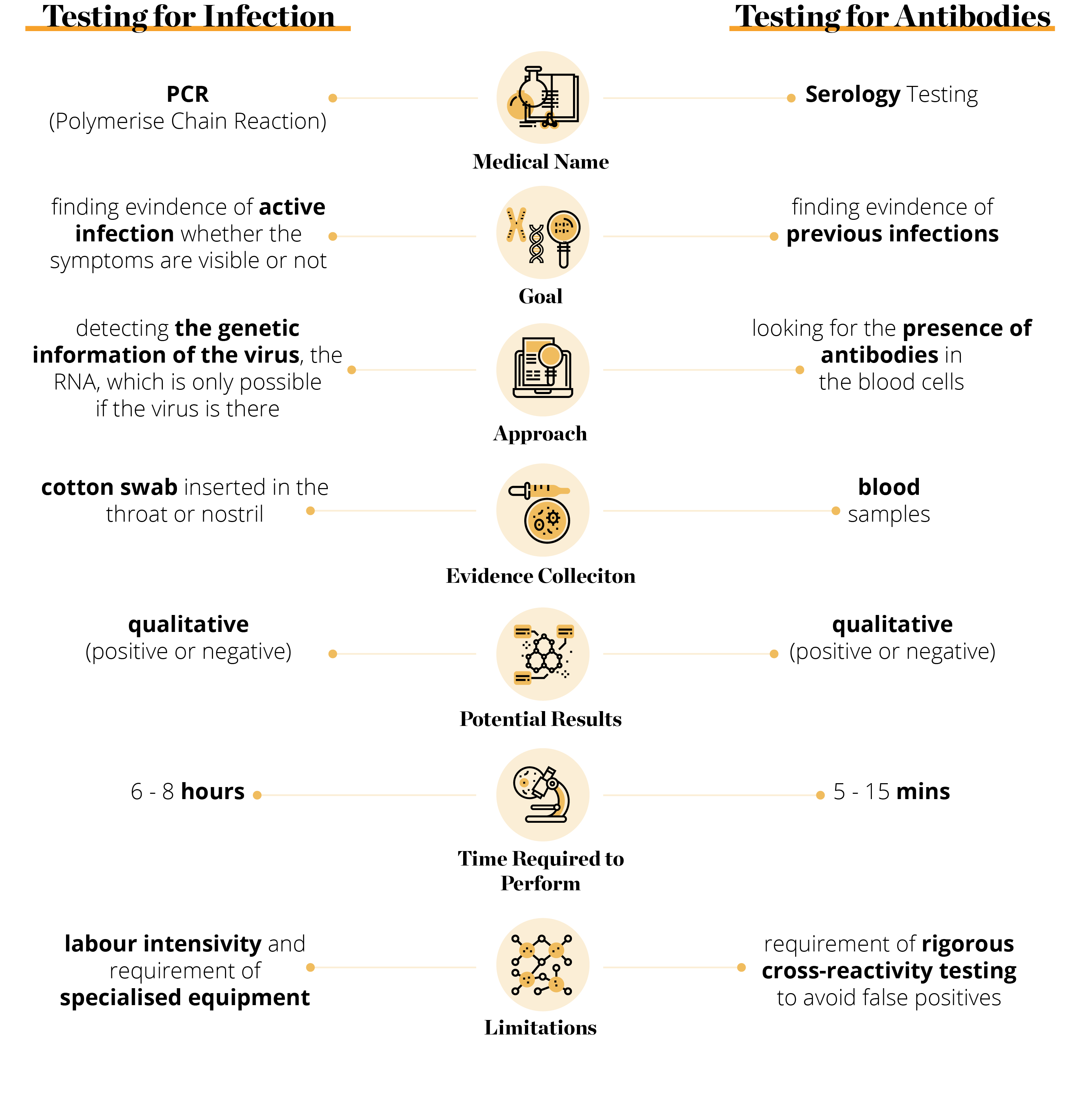
Figure 1: Infographic comparing two types of widely used tests during COVID-19
It is important to highlight that the number of tests conducted by countries commonly concerns the number of PCR tests, which diagnose the infection, since the serology tests can solely inform whether there is a presence of antibodies in one’s blood cells due to a prior infection. Thus, sufficient capacity for conducting PCR tests is an imperative for countries to control the outbreak. On the other hand, testing positive for the serology tests do not indicate immunity for individuals hence should not be mistaken for easing up the measures based on the result.
However, due to the labour-intensive nature of the PCR tests, the demand outpaced the supply in many countries and burdened healthcare systems. Consequently, a better ability to boost testing capacity early on in the outbreak provided a head start for some countries to fight the pandemic, as seen in South Korea.
Moreover, the tests present several other challenges. For PCR tests, the inaccuracy of the tests is a significant issue. According to the data from late April 2020, 15% of test results turned out to be false negatives, which can mislead efforts to contain the pandemic. On the other hand, false positives can be devastating for individuals incorrectly considered infective.
Though serology tests are quick to perform and have a relatively low cost, their nature makes that they cannot test whether an individual is immune. Furthermore, the tests are not specific enough to identify immunity responses to COVID-19, wherefore it is important not to rely on the result of this test right away. Instead, one should perform additional testing to identify whether the antibodies were produced to combat COVID-19 or another coronavirus to avoid false outcomes
In retrospective, only a few countries developed testing strategies timely
Though the theory behind testing is sensible, testing strategies widely differed across countries in the early stages of COVID-19, and numerous countries did not prioritise building a solid testing strategy.
Some of these countries argued that individuals who potentially contracted COVID-19 would not benefit from knowing whether they actually had the virus. They suggested that these individuals should stay at home in any case, isolate themselves and wait until they got better, often except for individuals with high risk of contracting COVID-19 or severely ill individuals. Furthermore, even if a country aimed to make COVID-19 tests widely available, shortages in tests, costs and a lack of skilled medical staff decreased feasibility of this approach.
Below we will illustrate how exactly testing strategies amongst countries differed, drawing on numerous interactive visuals on testing provided by the Our World in Data initiative.
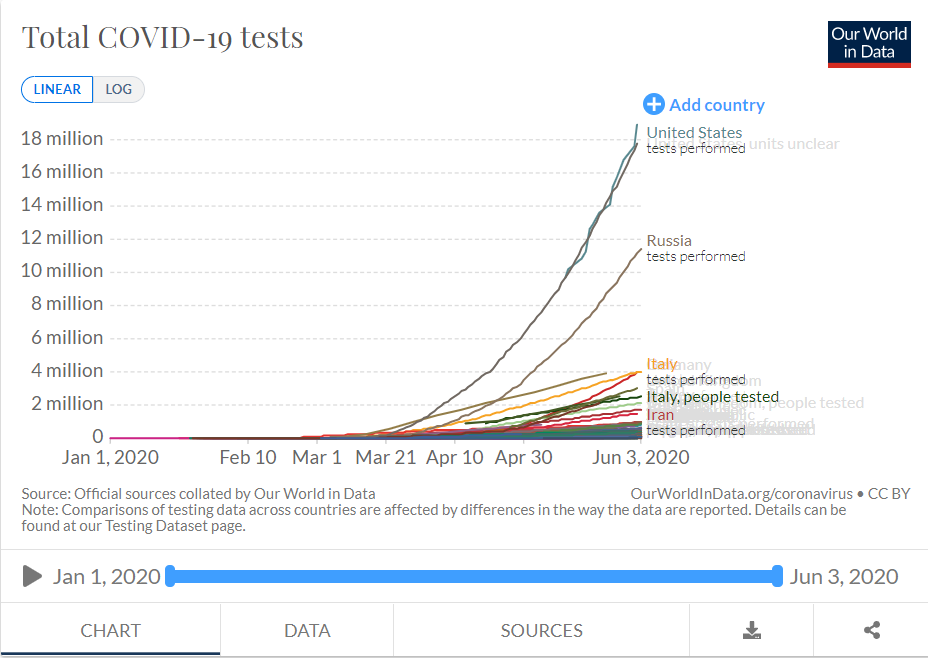
Figure 2: Screenshot of daily COVID-19 test per thousand people between1 February 2020 and 1 June 2020.
The differences in testing for response strategies become visible when exploring the number of COVID-19 tests across countries, over time. Our World in Data provides an interactive visual of the number of tests conducted, and specifies how the number is obtained, as illustrated by figure 2. The data behind this figure indicates that Mexico was the first country to start testing - already on 10 January 2020 - followed by South Korea. In Europe, Switzerland was the first country to start testing, on 31 January 2020, followed by the Czech Republic on 26 February 2020 and Finland on 28 February 2020.
When considering the pattern over time, South Korea maintained a relatively low testing ratio per thousand individuals, which is associated to the relatively fast success in flattening the curve. In contrast, testing capacity in the United States has tremendously increased over time, though some argue that testing capacity came too late and is still insufficient.
To gain further insight into testing strategies and at what speed these were taken up, the European Data Portal visualised the occurrence of COVID-19 cases against the number of tests performed for four European countries, as illustrated by figure 3.
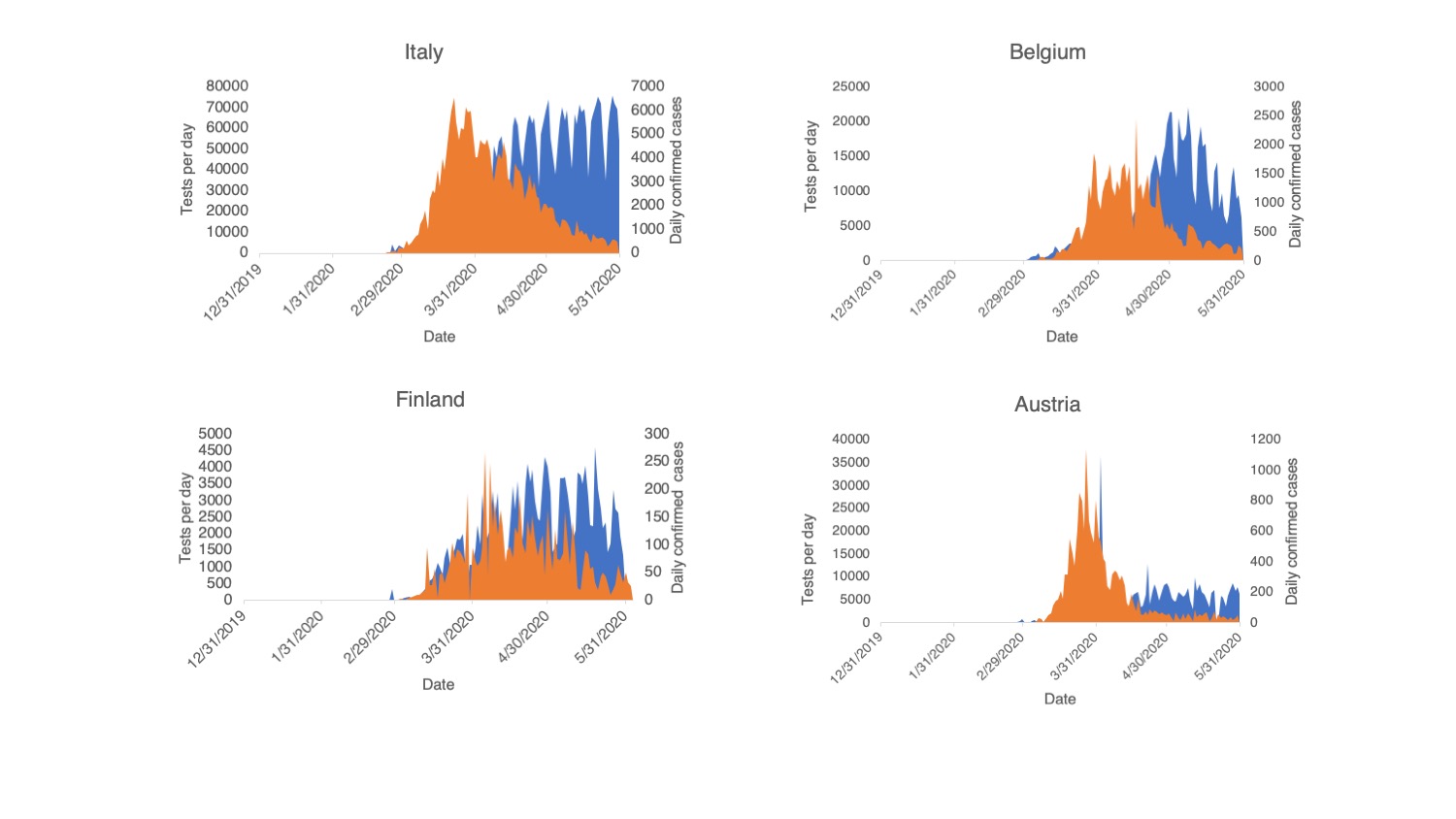
Figure 3: Comparison between confirmed COVID-19 cases and tests performed per day in four European countries. Data retrieved from Daily confirmed COVID-19 cases and Daily COVID-19 tests.
In the visual, the four European countries are illustrated for which accurate and complete datasets on the daily number of COVID-19 cases, as well as the number of tests performed, were available. The visual highlights different approaches to testing amongst the four countries. For example, Italy employs widespread testing, in comparison to their current number of daily COVID-19 cases. Like Italy, Belgium increased the number of tests conducted daily only after the peak in COVID-19 cases, and continued testing when the number of cases decreased. For Finland, the trends seen in COVID-19 cases and testing are comparable. The trend in Austria is more comparable to Belgium, though the absolute number of COVID-19 cases and tests conducted is much smaller.
The visual above also draws attention to the fact that the availability of accurate and open data is lacking for most European countries. Improvements in availability of data would be beneficial towards examining how different testing strategies help bring transmission to a standstill.
Widespread testing gained popularity over time
Most European countries passed the peak in the number of COVID-19 infections before June 2020. When considering testing volumes over the months preceding that inflection point, a trend in the ramp up of testing capacity is visible, when compared to the number of confirmed COVID-19 cases Our World in Data provides insight into this trend, visualised in figure 4.
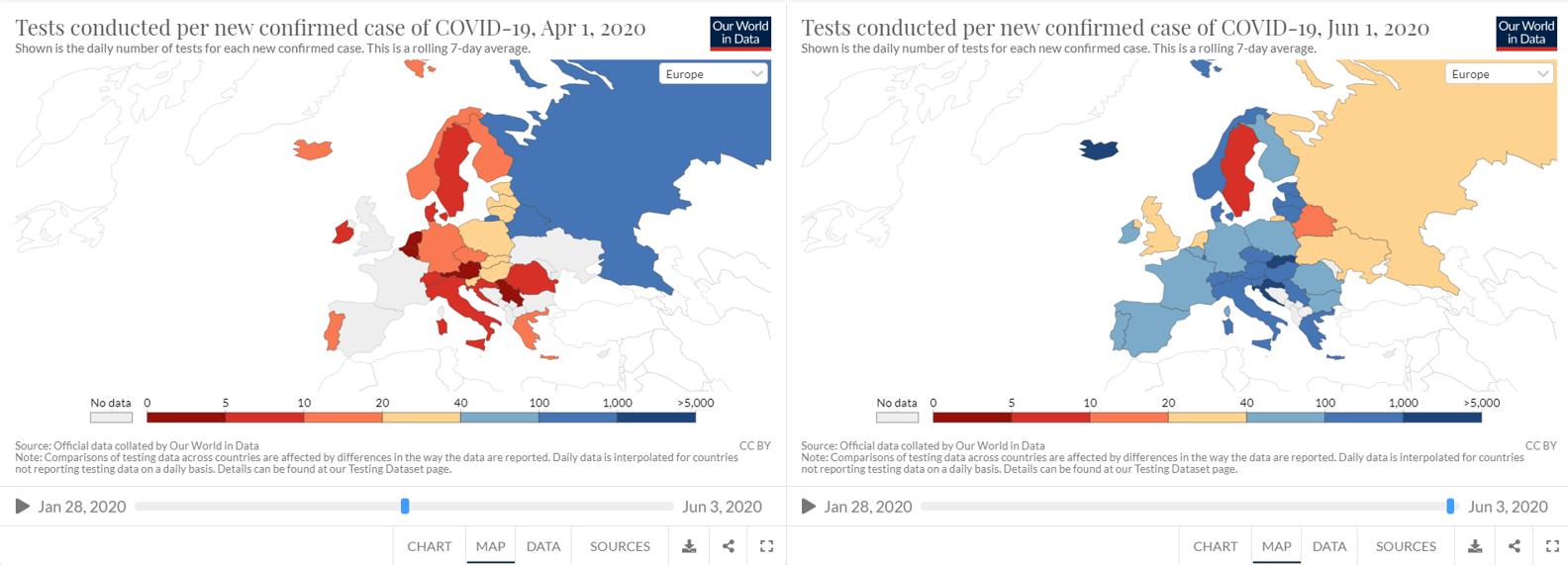
Figure 4: Tests conducted per new confirmed case of COVID-19 in Europe, comparison
between 1 April 2020 and 1 June 2020.
The comparison of the visualisations in figure 4 highlights that the extent to which most European countries conduct testing rose over time, when comparing the number of tests conducted to the number of cases identified.
Per illustration, Italy conducted 5-10 tests per confirmed case on 1 April 2020, though it developed testing capacity towards more widespread testing by 1 June 2020, when one confirmed case was found for each 100 to 1,000 tests. Croatia even improved from 5-10 tests per identified case towards 1,000-5,000 tests per confirmed case over the same period. Nonetheless, not all European countries follow the same trend, as Sweden’s capacity did not change over time.
Important is that, when a small number of tests is conducted per each confirmed case, such as was the case for Italy and Croatia on 1 April 2020, it suggests that not enough tests are carried out to properly monitor the size of the outbreak. Consequently, the actual number of cases may have been far higher than the number of confirmed cases.
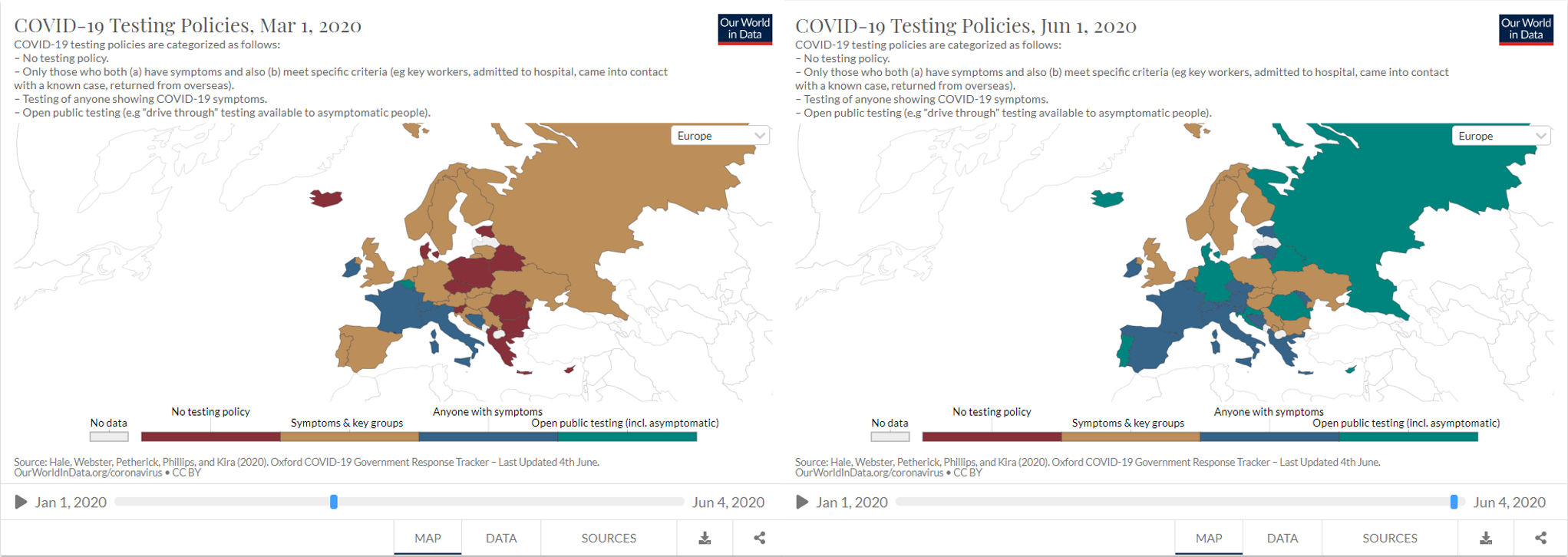
Figure 5: Testing policies among European countries – comparison of
1 March 2020 and 1 June 2020.
The number of tests conducted per confirmed case is expected to be higher when a country implements a widespread testing policy. Insight into testing policies amongst European countries is provided via the visualisation in figure 5.
Between 1 March and 1 June 2020, a shift is visible from policies where testing was not performed, or performed only for high risk individuals with symptoms, towards testing any citizen with symptoms, or even open public testing including asymptomatic individuals. Notably, testing is still relevant for asymptomatic people, as some individuals do not experience any symptoms though are carriers and transmitters of the virus.
The comparison in figure 5 makes evident that some countries, such as Germany, Portugal and Spain focused on the importance of increasing testing capacity, whereas others, such as Finland, Norway, Sweden and the UK were more satisfied with their ability to test specifically the individuals from key, high-risk groups with symptoms.
The future outlook on testing: Easing up measures and ramping up testing capacity
Reflecting on the different testing strategies employed by different countries, it becomes evident that effective, timely, and widespread testing is key for gaining access to accurate data to employ in combatting COVID-19. In the earlier days of the pandemic, when the number of tests were insufficient among multiple nations, prioritising the individuals in the higher risk groups was essential to ensure that tests were utilised most efficiently.
However, in order to manage the pandemic for a longer period of time and progress towards the new normal, channelling the efforts towards heightening testing capacity forms one of the essential steps. The shift towards increasing the testing capacity and making the tests available for wider groups is evident in most of the countries in the world and is associated with the new normal.
Nonetheless, increasing testing capacity and effectiveness is only a part of the battle we have to fight. Combining testing efforts with contact-tracing is a key step to maximise the potential spread of the virus, even though the exact means via which to conduct contact-tracing is a sensitive subject for some of the countries - as we analysed in one of the previous data stories.
Fighting the pandemic in a globalised world has presented its challenges to all countries worldwide. However, globalisation and increased capacity of data collection and data sharing made it possible to evaluate different strategies, learn from other countries’ best practices and enabled swift. These findings emphasise the importance of collecting accurate testing data and sharing it openly to strengthen our front and be better prepared for the future.
Contact form: https://www.europeandataportal.eu/en/feedback/form
Looking for more open COVID-19 related datasets or initiatives? Visit the EDP for COVID-19 curated lists and follow us on Twitter or LinkedIn.
